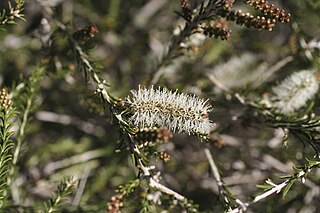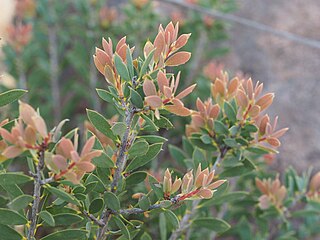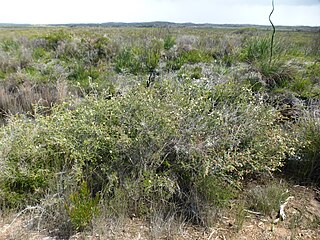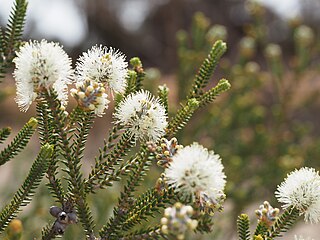
Melaleuca linariifolia is a plant in the myrtle family Myrtaceae, and is endemic to eastern Australia. It is commonly known as snow-in-summer, narrow-leaved paperbark, flax-leaved paperbark and in the language of the Gadigal people as budjur. A hardy plant, it flowers prolifically in late spring or summer, making it a popular garden shrub or small tree in temperate places. Melaleuca trichostachya is a similar species but its leaves are arranged differently and the fruits have projecting valves.

Melaleuca huegelii, commonly known as chenille honey-myrtle, is a plant in the myrtle family, Myrtaceae and is endemic to the south-west coastal areas of Western Australia. It has small, almost scale-like leaves and flower spikes sometimes more than 100 millimetres (4 in) long on the ends many of its branches.

Melaleuca dissitiflora, commonly known as creek tea–tree, is a plant in the myrtle family, Myrtaceae and is native to Australia. It occurs in the drier parts of Queensland, the Northern Territory, South Australia and Western Australia. It grows in places like sandy creek beds and rocky gorges but it may have potential as a more productive source of "tea tree" oil than the usual Melaleuca alternifolia. It is closely related and very similar to Melaleuca linophylla with its papery bark, narrow leaves and loose spikes of creamy-white flowers but its flowers are larger, the stamens are longer and there are more stamens per bundle than in that species.

Melaleuca fulgens, commonly known as the scarlet honey myrtle, is a plant in the myrtle family Myrtaceae, and is endemic to Western Australia, South Australia and the Northern Territory. It is notable for its showy orange, red or purple flowers, unusual foliage and fruit, and is a popular garden plant. It is a member of Melaleuca, a large and diverse genus whose members range from large trees such as M. quinquenervia, to small shrubs.

Melaleuca hnatiukii is a plant in the myrtle family, Myrtaceae and is endemic to the south of Western Australia. It is a medium to large shrub with arching branches, prickly tipped leaves and creamy-white heads of flowers in spring or early summer.

Melaleuca linguiformis is a plant in the myrtle family, Myrtaceae and is endemic to the south of Western Australia. It is a shrub with hairy new growth, small leaves and heads of white flowers similar to Melaleuca teuthidoides shorter sepals and more stamens in each flower.
Melaleuca apodocephala is a plant in the myrtle family, Myrtaceae and is endemic to the south-west of Western Australia. It is a low, bushy shrub with crowded, grey-green leaves, corky bark and a profusion of creamy-yellow flowers on the sides of the branches.

Melaleuca adnata, commonly known as sandhill honey-myrtle, is a plant in the myrtle family, Myrtaceae and is endemic to the south-west of Western Australia. It is a tall shrub with papery bark and spikes of white flowers in spring and early summer.

Melaleuca calothamnoides is a plant in the myrtle family, Myrtaceae and is endemic to a relatively small area on the west coast of Western Australia. It has attractive red and green flowering spikes and soft foliage but has proven to be difficult to grow in gardens.

Melaleuca deanei, commonly known as Deane's paperbark, is a plant in the myrtle family, Myrtaceae and is endemic to New South Wales in Australia. It is a shrub with flaky bark, narrow oval leaves and spikes of white flowers in spring and summer. The species only exists in a few isolated populations and is classified as vulnerable.

Melaleuca dichroma is a shrub in the myrtle family, Myrtaceae and is endemic to the south-west of Western Australia. It is unusual for its genus in that its flowers are yellow or creamy-white but age to a pinkish-red.

Melaleuca eleuterostachya is a plant in the myrtle family, Myrtaceae and is endemic to Western Australia and South Australia. It is a shrub or tree with arching branches, narrow leaves and small spikes of cream or white flowers.

Melaleuca filifolia, commonly called wiry honey-myrtle, is a plant in the myrtle family Myrtaceae, and is endemic to the south-west of Western Australia. It is a woody, twiggy shrub with needle-shaped leaves, greenish flower buds, pink "pom-pom" flower heads and spherical clusters of fruits.

Melaleuca incana, commonly known as grey honey-myrtle, is a plant in the myrtle family, Myrtaceae and is endemic to the south-west of Western Australia and is naturalised in the south of Victoria in Australia. It is commonly grown as a garden plant and produces large numbers of white or creamy yellow flowers, sometimes highly scented, in spring.

Melaleuca incana subsp. tenella is a plant in the myrtle family Myrtaceae which is endemic to the south coast of Western Australia. It was formerly known as Melaleuca tenella Benth. but was reduced to a subspecies in 1998. It is similar to M. incana subsp. incana except in the form of the plant, the size and shape of its leaves, its flowering time and distribution.
Melaleuca linophylla is a plant in the myrtle family Myrtaceae and is native to the north-west of Western Australia. It is a bushy shrub with narrow leaves and spikes of cream-coloured flowers in spring. It is distinguished by its fruits which are much more urn-shaped than those of other melaleucas.

Melaleuca megacephala is a plant in the myrtle family Myrtaceae and is native to the south-west of Western Australia. It is distinguished by its large, hemispherical heads of yellow and white flowers on the ends of the branches and the overlapping brown bracts under them.
Melaleuca nanophylla, commonly known as dwarf-leaved honey-myrtle is a rare plant in the myrtle family, Myrtaceae and is endemic to two small areas, one in Western Australia and the other in South Australia. It has tiny leaves with their upper surfaces pressed against the stems and small heads of white or pale yellow flowers.

Melaleuca quadrifaria, commonly known as limestone honey-myrtle, is a plant in the myrtle family, Myrtaceae, and is native to the south of Western Australia. It is distinguished by the small size and arrangement of its leaves combined with its small spikes of white or cream flowers.

Melaleuca ringens is a plant in the myrtle family, Myrtaceae, and is endemic to the south-west of Western Australia. It shares some features with Melaleuca diosmifolia but has creamy yellow flower spikes and a lower, more spreading form.

















